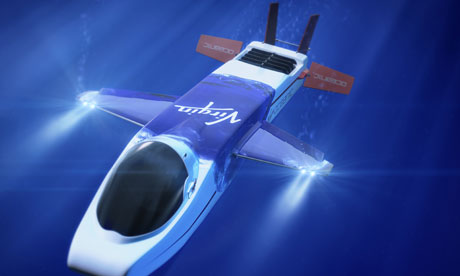
An artist's concept of Virgin Oceanic Submarine Virgin Oceanic Expedition. Photograph: Virgin Oceanic / Rex Features
You have the private plane, the luxury yacht and the helicopter. Only one hi-tech goody is missing from your list of billionaire playthings – a submarine to take you to the bottom of the ocean.
But now, thanks to a revolution in the manufacture of ultra-strong materials and advanced guidance systems, such a super-submersible is being built, and sold, by marine companies. Soon the abyss, and the strange denizens that inhabit its stygian depths, will be filled with packs of tiny submarines piloted by hedge-fund managers and venture capitalists.
Among those who have already shown keen interest, either in funding or buying super-submersibles, are film director James Cameron, Google executive chairman Eric Schmidt and entrepreneur Richard Branson.
"Ninety per cent of the sea bed has still to be explored," said Patrick Lahey, president of Triton Submarines of Vero Beach, Florida. "There is a host of wonders down there. You could visit the mid-Atlantic thermal vents, where volcanic heated gases bubble up from Earth's core, or cruise down to the wrecks of the Titanic or the Bismarck. You will be able to access any place in the ocean and watch all those wonderful sea creatures."
Craft that can take two or three passengers on dives of 300 metres are already being built and sold by firms such as Triton or Deep Flight, which is based in California and was set up by UK marine engineer Graham Hawkes. The latter's craft have appeared in Bond films and have been sold to Richard Branson and venture capitalist Tom Perkins.
The depths achieved by these submarines are still relatively modest. However, versions are now being designed to survive dives down to 1,000 metres, depths normally frequented by military submarines. "These should be ready for their first journeys in the next few months," added Lahey.
However, it is the prospect of craft that would take their owners right down to the very deepest parts of the oceans that will create the greatest stir among thrill-seeking billionaires. Sites include the Challenger Deep, part of the Mariana Trench, near the Mariana Islands, in the Pacific. There is no light here, 11,000 metres below the surface, and the water pressure is a thousand times that of the atmosphere at sea level.
Nevertheless, several companies say they are now designing craft that will withstand these colossal pressures.
"We will use a sphere of special glass that is more than four inches thick for the main part of our submersible," said Lahey. "It will give its three passengers an all-round view of everything that is going on down there – though, obviously, when we get very deep, we will have to use pretty powerful lamps to illuminate proceedings."
By contrast, Deep Flight Challenger, a one-person, high-performance, experimental, prototype submersible designed by Hawkes, looks more like a plane and uses hydrodynamic force to propel the craft down. It is designed to dive to depths of 11,000 metres and was originally intended to be piloted by Steve Fossett, the US adventurer killed during an aircraft flight in 2007.
"It's about 24 feet long, with a 10-foot wingspan," Hawkes has said. "The pressure hull is made of a custom-designed carbon fibre, with very thick walls. Inside, we provide an artificial atmosphere. The pilot is not subjected to any pressure differences whatsoever. There's a big window in the front that's covered by a Plexiglas streamline canopy. The deep water typically is clear, so there will be lots to see. And it doesn't look like it, but the inside is actually a comfortable space."
In addition, James Cameron has formed a team which has been building its own deep-sea craft. This will cost around $8m and Cameron says he intends to use it to dive to the bottom of the Kermadec-Tonga trench, north of New Zealand, next summer.
And finally, there is the submersible backed by Google executive chairman Eric Schmidt through Deep Ocean Exploration and Research, a company based on Alameda Island in San Francisco Bay.
The torpedo-shaped Deepsearch looks more like a traditional submarine than any of its competitors.
It will hold up to three people and would plunge the 11km to the ocean's floor in little more than an hour. Its personnel sphere, like that of the Triton model, will also be made of glass for better viewing.
"The goal is not a stunt dive" but to open up "a world asset capable of providing scientists with unlimited access to the deep ocean," says the website of the company which aims to sell each Deepsearch for around $40m.
So far it has plans to build two, it says. Undersea transport has changed remarkably since it was imagined by Jules Verne in 20,000 Leagues Under the Sea.
"We are at the stage that we were in during the 1960s, when the very first private helicopters were used to ferry people to and from yachts," added Lahey. "This technology is less functional, I suppose, but it is a lot more exciting."

No comments:
Post a Comment